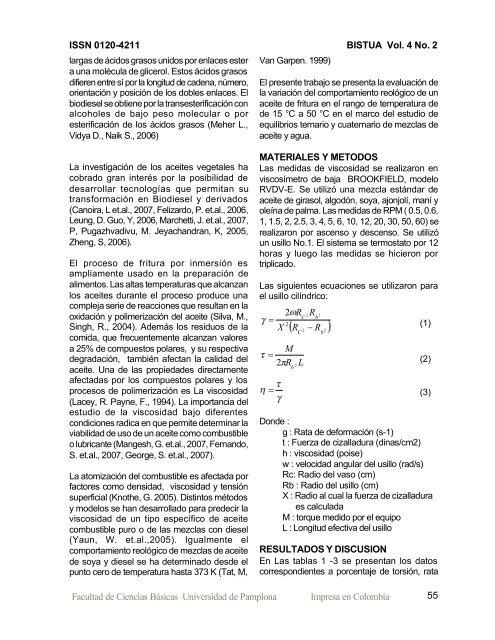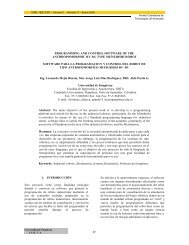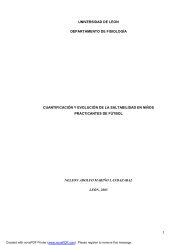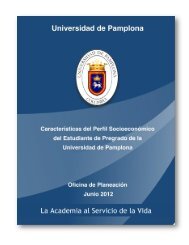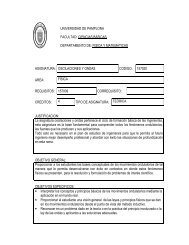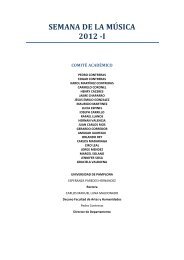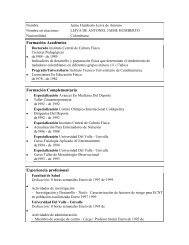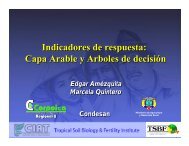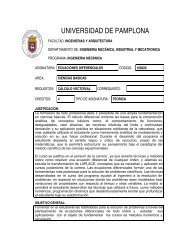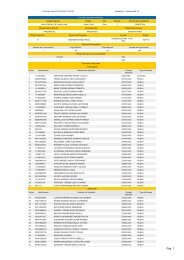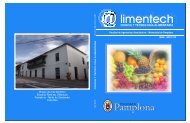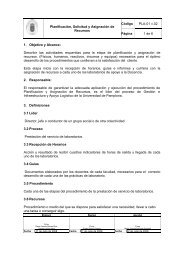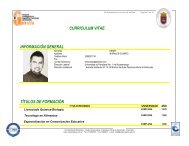Análisis de la variación de la viscosidad cinemática de un aceite ...
Análisis de la variación de la viscosidad cinemática de un aceite ...
Análisis de la variación de la viscosidad cinemática de un aceite ...
You also want an ePaper? Increase the reach of your titles
YUMPU automatically turns print PDFs into web optimized ePapers that Google loves.
ISSN 0120-4211<br />
<strong>la</strong>rgas <strong>de</strong> ácidos grasos <strong>un</strong>idos por en<strong>la</strong>ces ester<br />
a <strong>un</strong>a molécu<strong>la</strong> <strong>de</strong> glicerol. Estos ácidos grasos<br />
difieren entre sí por <strong>la</strong> longitud <strong>de</strong> ca<strong>de</strong>na, número,<br />
orientación y posición <strong>de</strong> los dobles en<strong>la</strong>ces. El<br />
biodiesel se obtiene por <strong>la</strong> transesterificación con<br />
alcoholes <strong>de</strong> bajo peso molecu<strong>la</strong>r o por<br />
esterificación <strong>de</strong> los ácidos grasos (Meher L.,<br />
Vidya D., Naik S., 2006)<br />
La investigación <strong>de</strong> los <strong>aceite</strong>s vegetales ha<br />
cobrado gran interés por <strong>la</strong> posibilidad <strong>de</strong><br />
<strong>de</strong>sarrol<strong>la</strong>r tecnologías que permitan su<br />
transformación en Biodiesel y <strong>de</strong>rivados<br />
(Canoira, L et.al., 2007, Felizardo, P. et.al., 2006,<br />
Le<strong>un</strong>g, D. Guo, Y, 2006, Marchetti, J. et.al., 2007,<br />
P, Pugazhvadivu, M. Jeyachandran, K, 2005,<br />
Zheng, S, 2006).<br />
El proceso <strong>de</strong> fritura por inmersión es<br />
ampliamente usado en <strong>la</strong> preparación <strong>de</strong><br />
alimentos. Las altas temperaturas que alcanzan<br />
los <strong>aceite</strong>s durante el proceso produce <strong>un</strong>a<br />
compleja serie <strong>de</strong> reacciones que resultan en <strong>la</strong><br />
oxidación y polimerización <strong>de</strong>l <strong>aceite</strong> (Silva, M.,<br />
Singh, R., 2004). A<strong>de</strong>más los residuos <strong>de</strong> <strong>la</strong><br />
comida, que frecuentemente alcanzan valores<br />
a 25% <strong>de</strong> compuestos po<strong>la</strong>res, y su respectiva<br />
<strong>de</strong>gradación, también afectan <strong>la</strong> calidad <strong>de</strong>l<br />
<strong>aceite</strong>. Una <strong>de</strong> <strong>la</strong>s propieda<strong>de</strong>s directamente<br />
afectadas por los compuestos po<strong>la</strong>res y los<br />
procesos <strong>de</strong> polimerización es La <strong>viscosidad</strong><br />
(Lacey, R. Payne, F., 1994). La importancia <strong>de</strong>l<br />
estudio <strong>de</strong> <strong>la</strong> <strong>viscosidad</strong> bajo diferentes<br />
condiciones radica en que permite <strong>de</strong>terminar <strong>la</strong><br />
viabilidad <strong>de</strong> uso <strong>de</strong> <strong>un</strong> <strong>aceite</strong> como combustible<br />
o lubricante (Mangesh, G. et.al., 2007, Fernando,<br />
S. et.al., 2007, George, S. et.al., 2007).<br />
La atomización <strong>de</strong>l combustible es afectada por<br />
factores como <strong>de</strong>nsidad, <strong>viscosidad</strong> y tensión<br />
superficial (Knothe, G. 2005). Distintos métodos<br />
y mo<strong>de</strong>los se han <strong>de</strong>sarrol<strong>la</strong>do para pre<strong>de</strong>cir <strong>la</strong><br />
<strong>viscosidad</strong> <strong>de</strong> <strong>un</strong> tipo específico <strong>de</strong> <strong>aceite</strong><br />
combustible puro o <strong>de</strong> <strong>la</strong>s mezc<strong>la</strong>s con diesel<br />
(Ya<strong>un</strong>, W. et.al.,2005). Igualmente el<br />
comportamiento reológico <strong>de</strong> mezc<strong>la</strong>s <strong>de</strong> <strong>aceite</strong><br />
<strong>de</strong> soya y diesel se ha <strong>de</strong>terminado <strong>de</strong>s<strong>de</strong> el<br />
p<strong>un</strong>to cero <strong>de</strong> temperatura hasta 373 K (Tat, M,<br />
Van Garpen. 1999)<br />
El presente trabajo se presenta <strong>la</strong> evaluación <strong>de</strong><br />
<strong>la</strong> <strong>variación</strong> <strong>de</strong>l comportamiento reológico <strong>de</strong> <strong>un</strong><br />
<strong>aceite</strong> <strong>de</strong> fritura en el rango <strong>de</strong> temperatura <strong>de</strong><br />
<strong>de</strong> 15 °C a 50 °C en el marco <strong>de</strong>l estudio <strong>de</strong><br />
equilibrios ternario y cuaternario <strong>de</strong> mezc<strong>la</strong>s <strong>de</strong><br />
<strong>aceite</strong> y agua.<br />
MATERIALES Y METODOS<br />
Las medidas <strong>de</strong> <strong>viscosidad</strong> se realizaron en<br />
viscosímetro <strong>de</strong> baja BROOKFIELD, mo<strong>de</strong>lo<br />
RVDV-E. Se utilizó <strong>un</strong>a mezc<strong>la</strong> estándar <strong>de</strong><br />
<strong>aceite</strong> <strong>de</strong> girasol, algodón, soya, ajonjolí, maní y<br />
oleína <strong>de</strong> palma. Las medidas <strong>de</strong> RPM ( 0.5, 0.6,<br />
1, 1.5, 2, 2.5, 3, 4, 5, 6, 10, 12, 20, 30, 50, 60) se<br />
realizaron por ascenso y <strong>de</strong>scenso. Se utilizó<br />
<strong>un</strong> usillo No.1. El sistema se termostato por 12<br />
horas y luego <strong>la</strong>s medidas se hicieron por<br />
triplicado.<br />
Las siguientes ecuaciones se utilizaron para<br />
el usillo cilíndrico:<br />
2 2<br />
C b<br />
= 2<br />
X R 2 − R<br />
(1)<br />
2<br />
C b<br />
=<br />
2<br />
Facultad <strong>de</strong> Ciencias Básicas Universidad <strong>de</strong> Pamplona Impresa en Colombia<br />
2<br />
M<br />
R<br />
b 2<br />
R<br />
L<br />
R<br />
BISTUA Vol. 4 No. 2<br />
(2)<br />
= (3)<br />
Don<strong>de</strong> :<br />
g : Rata <strong>de</strong> <strong>de</strong>formación (s-1)<br />
t : Fuerza <strong>de</strong> cizal<strong>la</strong>dura (dinas/cm2)<br />
h : <strong>viscosidad</strong> (poise)<br />
w : velocidad angu<strong>la</strong>r <strong>de</strong>l usillo (rad/s)<br />
Rc: Radio <strong>de</strong>l vaso (cm)<br />
Rb : Radio <strong>de</strong>l usillo (cm)<br />
X : Radio al cual <strong>la</strong> fuerza <strong>de</strong> cizal<strong>la</strong>dura<br />
es calcu<strong>la</strong>da<br />
M : torque medido por el equipo<br />
L : Longitud efectiva <strong>de</strong>l usillo<br />
RESULTADOS Y DISCUSION<br />
En Las tab<strong>la</strong>s 1 -3 se presentan los datos<br />
correspondientes a porcentaje <strong>de</strong> torsión, rata<br />
55


